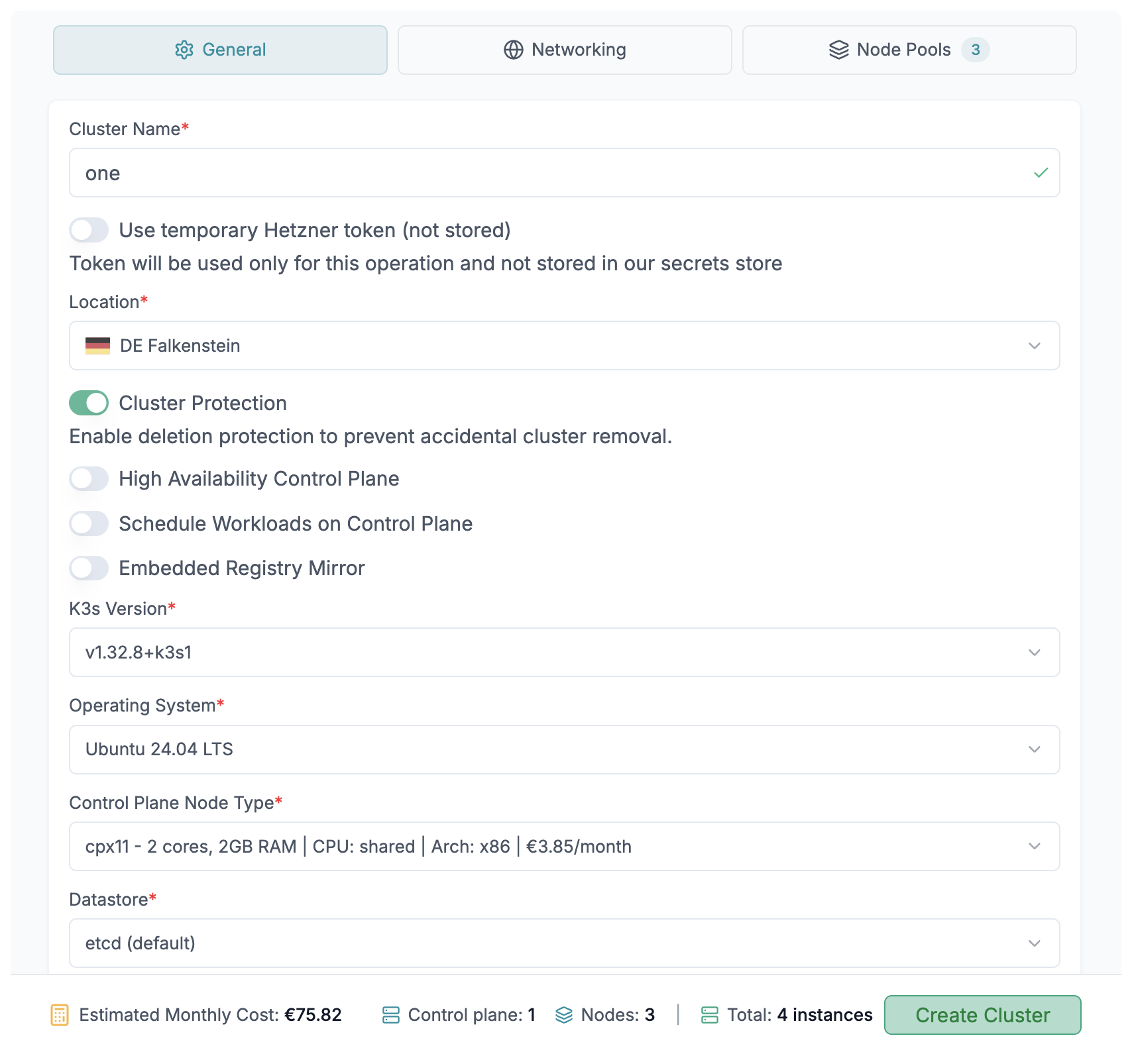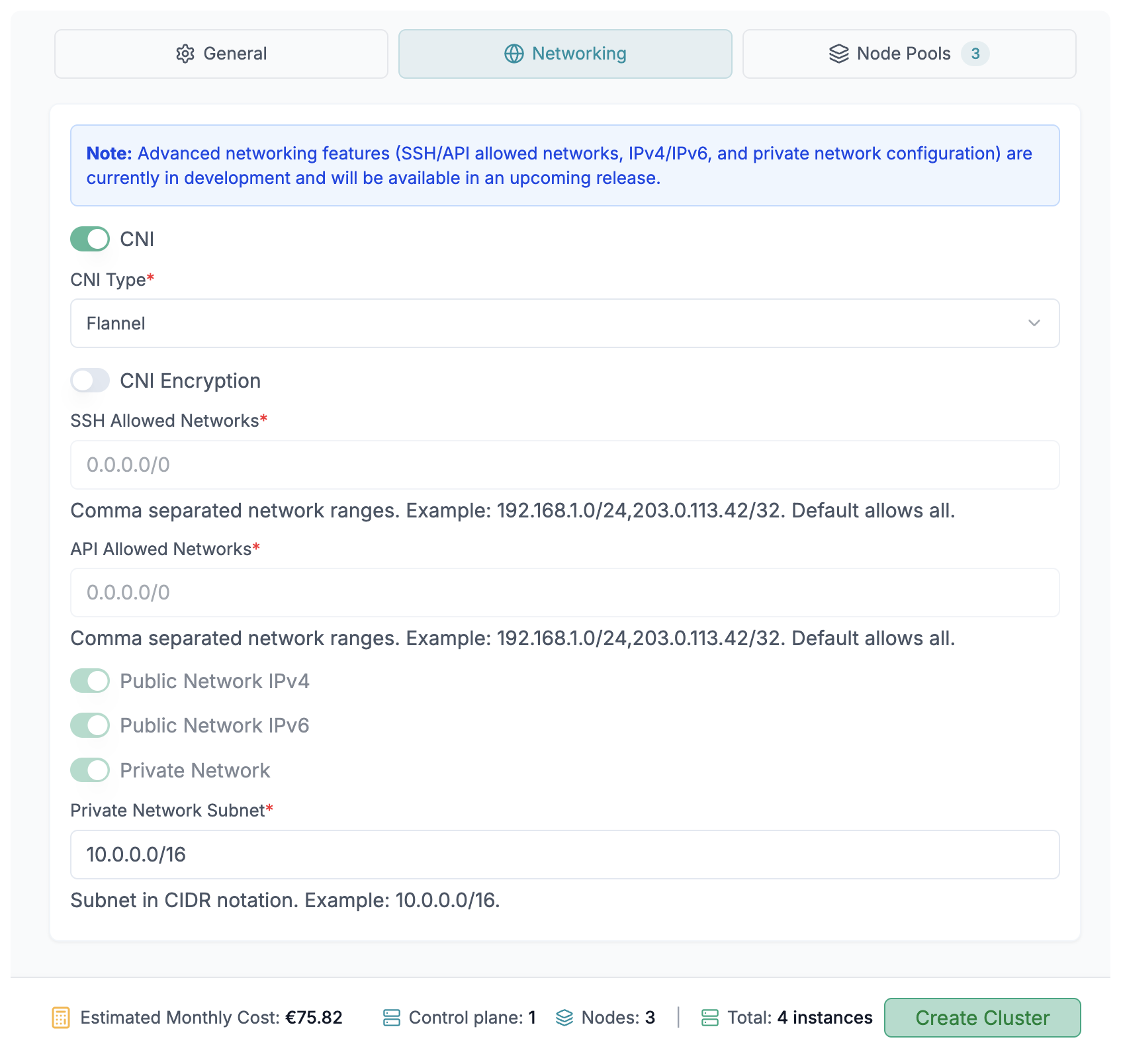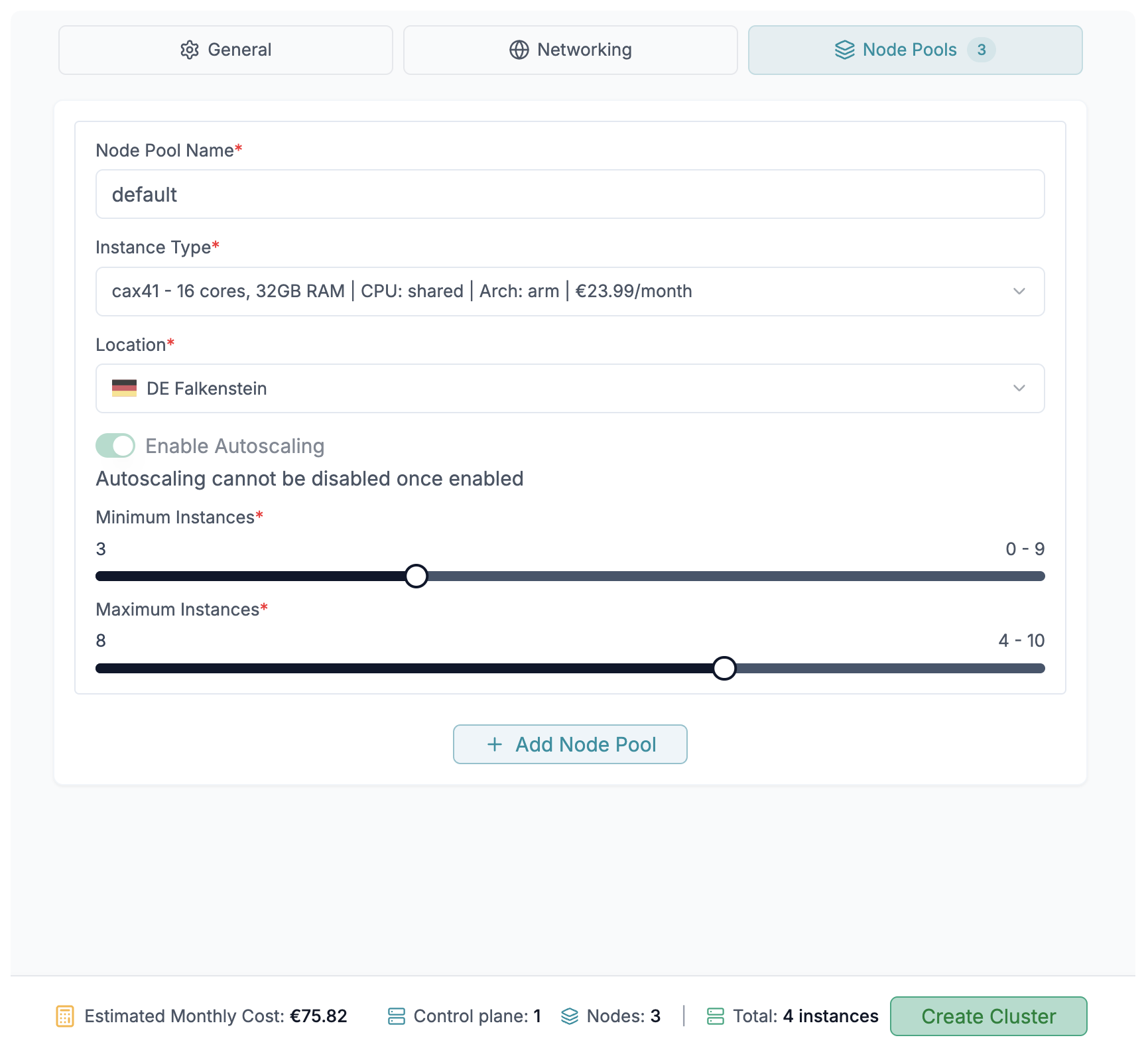Create a Kubernetes Cluster
This guide explains how to create, manage, and customize Kubernetes clusters using Edka.
Prerequisites
Before creating a cluster, ensure you have:
- An Edka account (sign up here)
- A Hetzner Cloud account and API token. See how to create them in our Prerequisites page.
- Basic understanding of Kubernetes concepts (helpful but not strictly required)
Basic configuration
In the Edka dashboard, click on Clusters in the main navigation, then click the Create Cluster button.
Cluster Name
Choose a descriptive name for your cluster (e.g., “production”, “staging”, “dev”). This name will be used to identify your cluster throughout the platform.
Region Selection
Select the Hetzner region closest to your users or applications:
- Germany: Nuremberg (nbg1), Falkenstein (fsn1)
- Finland: Helsinki (hel1)
- USA: Ashburn (ash), Hillsboro (hil)
- Singapore: Singapore (sin)
Cluster size
Feel free to adjust the cluster size to your needs. By default, Edka provisions a single instance control plane and one worker node. Usually the minimum necessary to run development and testing environments and in some situations even production workloads. You’re free to scale up the control plane and create as many worker nodes as you need (up to 50 nodes per cluster).
Control Plane Configuration

Kubernetes Version
Select the Kubernetes version for your cluster. Edka uses the k3s distribution of Kubernetes and usually supports the latest stable version. You can find more information about the latest k3s releases on the official k3s repository. If you need support for a specific version, please contact us.
Use temporary Hetzner token
Your Hetzner token will be used for a single cluster operation and not stored in our secrets store. Each time you need to perform an operation at cluster level, you will need to provide the same token again.
Cluster operations requiring a Hetzner token
- Creating a new cluster
- Updating cluster size
- Upgrading Kubernetes version
- Deleting a cluster
- Enabling cluster autoscaler
Cluster Protection
Enable deletion protection to prevent accidental cluster removal. It can be disabled later in the cluster settings.
High Availability Control Plane
Choose your control plane setup: The Control Plane is managing your Kubernetes cluster state and is the single point of failure for your cluster. If you need high availability, you can opt for a highly available control plane (3 instances).
- Single Instance: Development and testing environments
- High Availability (3 instances): Production environments (recommended)
Schedule Workloads on Control Plane Nodes
You can schedule workloads on the control plane. This is useful for development and testing environments and we do not recommend running production workloads on the control plane.
Embedded Registry Mirror
K3s embeds Spegel, a stateless distributed OCI registry mirror that allows peer-to-peer sharing of container images between nodes in a Kubernetes cluster. You can learn more about it in the k3s official documentation.
Operating System
You can choose between official Hetzner OS images for Ubuntu 24.04 (default), Debian 13 (Trixie) and Rocky Linux 10. We plan extending this list with other official images from Hetzner and add support for openSUSE MicroOS and custom images. Selcted operating system will be used for both the control plane and the node pools.
Control Plane Node Type
Specify the type of the control plane node depending on your workload requirements. Make sure you choose a node type that is compatible with your application.
Note: Arm64 architecture with Ampere® Altra® processors are only available in Germany (nbg1 and fsn1) and Finland (hel1).
Please refer to the Hetzner Cloud pricing page for the latest available node types available on each region.
Datastore
You can opt to store your cluster state in an embedded etcd or use an external database.
Etcd
The default etcd datastore for K3s.
External Database
The following external datastores are supported:
- etcd (certified against version 3.5.21)
- MySQL (certified against versions 8.0 and 8.4)
- MariaDB (certified against version 10.11, and 11.4)
- PostgreSQL (certified against versions 15.12, 16.7, and 17.3)
For more informations on the supported datastores, please refer to the K3s documentation.
Networking

CNI Selection
CNI (Container Network Interface) is responsible for managing the network connectivity between the nodes in the cluster.
Flannel (default)
- Pros: Simple, low overhead
- Cons: Basic features; not scaling well on large clusters
- Best for: Small and medium clusters, straightforward networking
Cilium
- Pros: eBPF based, high performance, rich policy and observability
- Cons: Heavier and more operationally complex
- Best for: Medium to large clusters, strong security/visibility needs
CNI encryption
You can encrypt the traffic between the nodes in the cluster. This can be useful for nodes that are not part of a private network.
SSH Allowed Networks (coming soon)
You can specify the IP addresses that are allowed to access the nodes in the cluster via SSH. Currently under development.
API Allowed Networks (coming soon)
You can specify the IP addresses that are allowed to access your Kubernetes API of the cluster. Currently under development.
Public/Private Network configuration
By default, Edka provisions a private network for the cluster and also assigns public IPs (IPv4 and IPv6) to the nodes in the cluster. Option to disable any of these is currently under development.
Private Network Subnet
You can specify the subnet for the private network. The default is 10.0.0.0/16. If you plan to deploy multiple clusters in the same Hetzner Project, we recommend using a different subnet for each cluster.
Node Pools
Configuration
You can specify the name for the node pool, the type of the node and the number of instances you want to provision in the node pool, up to 10 nodes per node pool.
Autoscaling
You can enable autoscaling for each node pool. This will automatically scale the number of instances in the node pool based on the workload. You can specify the minimum and maximum number of instances in the node pool.
